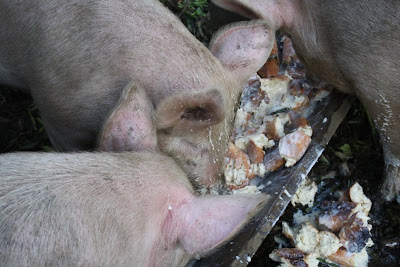The pigs were, of course, raised for food. And to eat pig one has to go through the messy business of killing it. So it was that the next time I saw the pigs, about 4 weeks after I met them, was the day they died.
I didn't sleep very much or very well the night before the slaughter. When I woke up to falling snow I thought (hoped?) that Neil might call and say it was off. He didn't. He called, instead, to ask me to pick up coffee for him and Pete on my way out. Large. Coffee. And whiskey, he joked. They were a bit nervous about the whole thing too.
I parked at Neil's house and walked over to the farm. The pigs, thinking there might be something in the Dunkin' Donuts cups for them, crowded to the edge of the yard, careless of the electric fence. To get to the barn, where I thought Neil and Pete might have been making final preparations, I had to cross the yard. The pigs made this crossing next to impossible. I put one rubber booted foot into the yard followed by the other trying to avoid the electric fence and keep my balance at the same time, which wasn't easy with three pigs attaching themselves to my legs. It was a difficult crossing for another reason too. Not only was I trying to keep upright, avoid the electric fences, and keep from spilling the coffee, I also found myself trying to avoid making eye contact with the pigs.
Physical and psychological hurdles finally managed, I got to the barn only to find it empty. I tried the other barn. Neil and Pete weren't there either. I could only think, then, that they were in the house. And they were. I found them in the kitchen going over the game plan. They jumped on the coffee, thanked me, and asked me how I was. "Kind of nervous, actually," I said. They told me they were too, actually.
Pete showed me the order of events. He had written it down in Sharpie on a large piece of discarded cardboard. Shoot, stick, scrape, hang, cut off the head, score the belly, rip the belly, loosen and tie the bung, gut, score the back, cut the spine. We took a look at the equipment: knives, a spool of yellow twine, and a gun. Neil and I were both taken aback by the gun. We knew the pigs had to be shot, but to actually be in the same room as a loaded pistol was something strange to both of us. "Is it loaded?" Neil asked. "Well, yeah," Pete said. "Does it have a safety?" Neil asked. "No, I don't think so," Pete said. Oh. He then went onto the porch to smoke one of several--and, I'm sure, much needed--cigarettes. "I'll quit tomorrow," he kept saying, "but today I need these."
It seemed we all found ways to delay the killing of the pigs. Pete had another cigarette, Neil decided to change his trousers, I went to the toilet. Maybe Pete did need another smoke. Maybe Neil's trousers were too warm. Maybe I did have to pee. Maybe none of us wanted to see the pigs shot.
Eventually we made our way down to the yard. It was when Neil and I were emptying 10 Guinness into a bucket to give to the pigs that I learned they had not eaten since the previous morning. No wonder they had showed such an interest in me and my coffee cups. Neil had seen it done before--feeding Guinness to pigs before slaughter. It calmed them down, he explained, and made things go a little more smoothly. The pigs were worked up, so, if it worked, why not? Pete had seen it done before too. "Yeah, it calmed one of 'em down," he said, "The other one just wanted to fight." I guess pigs can be mean drunks too. We gave them the Guinness in spite of Pete's cautionary tale and after a while it started to take effect. It was noticeable in the smallest one first, but by and by they all quietened down and became unsteady on their trotters. They mostly forgot they were hungry, but to distract them from the whole shooting-your-sibling-in-the-head thing we put some soy milk in the trough, which they went to readily. As they stood there slopping up the milk, Pete walked up to one the pigs, pressed the pistol to its forehead, and squeezed the trigger.












